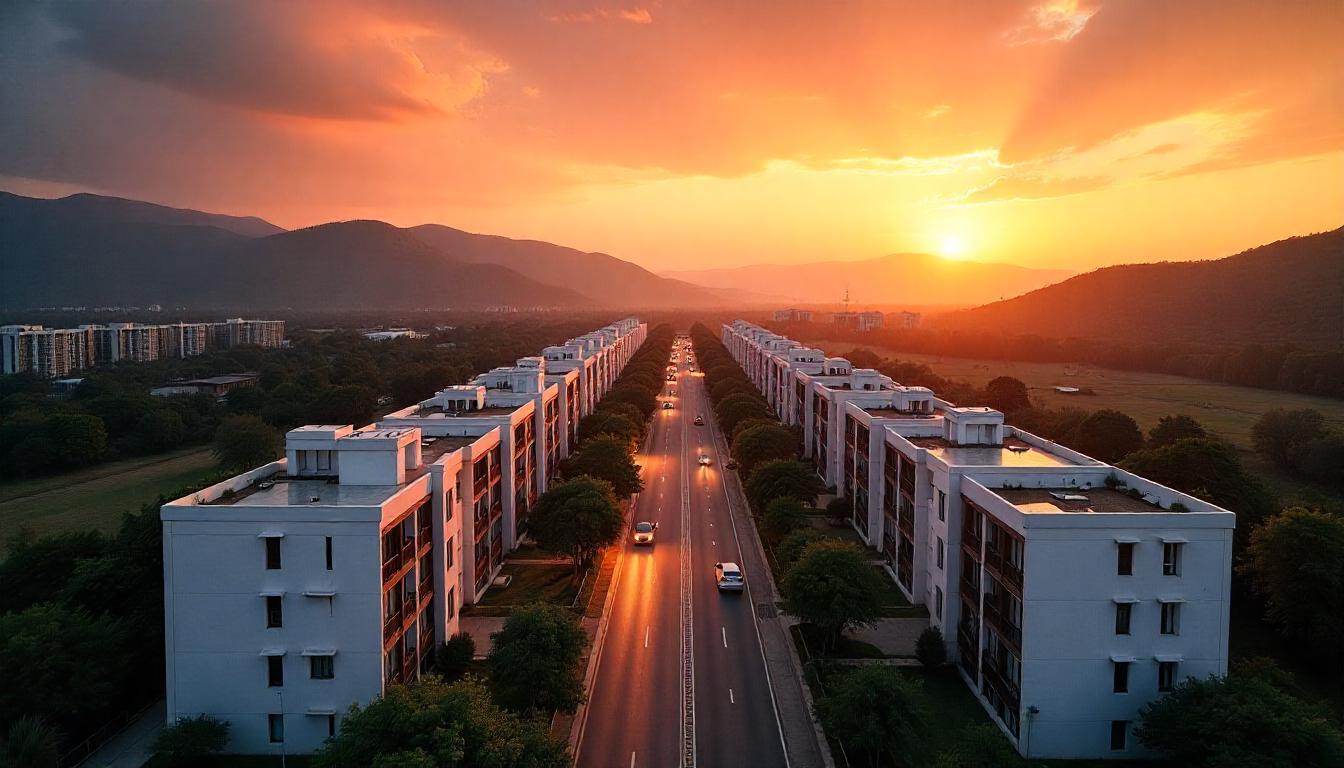
Blog
We keep you up to date on the most recent real estate news and events.
Future-Ready Living: How Nature-Rich Integrated Townships Are Redefining Urban India
“Imagine a city within a city—where nature, wellness, and technology come together to define a better way of life.”
India’s real estate market is at a pivotal juncture. By 2030, the industry is expected to grow to a $1 trillion market, accounting for roughly 13% of India’s GDP, fueled by rapid urban growth and shifting buyer demands. Amid this transformation, integrated townships are emerging as a beacon of modern urban living, blending nature, technology, and community in ways that resonate deeply with today’s homebuyers. With 40% of India’s population—approximately 60 crore people—expected to reside in urban areas by 2030, the demand for sustainable, holistic living spaces is no longer a luxury but a necessity. This blog explores the rise of integrated townships, their nature-rich design, and why they’re redefining urban planning in India, particularly in tier-2 and tier-3 cities.
What Are Integrated Townships, and Why Are They Gaining Prominence?
Integrated townships are self-contained urban ecosystems that combine residential, commercial, recreational, and social infrastructure within a single, well-planned development. Unlike traditional residential projects, these townships create a seamless lifestyle by integrating schools, healthcare facilities, retail hubs, parks, and offices, all linked through intelligent infrastructure. Their rise in India is driven by their ability to tackle urban challenges like traffic congestion, pollution, and scattered amenities.
The growth of townships is supported by government programs such as the Smart Cities Mission and AMRUT, which focus on sustainable urban progress and enhanced livability across over 100 cities. The Real Estate Regulation and Development Act (RERA) has also boosted buyer trust by ensuring transparency and timely project completion, making townships a reliable investment choice. Since the pandemic, homebuyers have increasingly sought homes that offer more than just shelter; integrated townships provide convenience, safety, and community, perfectly matching this evolving preference.
For instance, projects like Trident Hills in Panchkula showcase how modern townships integrate luxury residences with green spaces and advanced amenities, catering to buyers seeking a balanced lifestyle without compromising urban connectivity. Such developments are setting benchmarks for what urban living can achieve.
The Role of Nature-Rich Living in Urban Planning
As India urbanises, the integration of nature into urban planning has become a cornerstone of sustainable development. Nature-rich living isn’t just about planting trees, it’s about creating environments that promote well-being, reduce environmental impact, and foster community. With urban air quality deteriorating, Delhi’s AQI often exceeds 300, classified as “hazardous”. Green spaces in townships act as vital lungs for cities.
Modern urban planning, influenced by frameworks like the Smart Cities Mission, emphasises walkable neighbourhoods, biophilic design, and green certifications. Bhubaneswar, for example, is leading the way with smart city designs that prioritise pedestrian-friendly layouts and cultural context. Nature-rich townships incorporate parks, urban forests, water bodies, and green rooftops, which not only enhance aesthetics but also mitigate heat islands and improve air quality. According to a Knight Frank India report, demand for eco-friendly buildings is surging among buyers and institutional investors, with green-certified projects commanding a premium.
Environmental Benefits
Green spaces in townships absorb carbon dioxide, reduce urban heat, and support biodiversity. A JLL India report highlights that sustainable buildings can cut energy use by as much as 30% and water consumption by 20%, supporting India’s environmental targets outlined by NITI Aayog. Features like rainwater harvesting, solar energy systems, and efficient waste management are now common in progressive townships, minimizing their ecological footprint.
Psychological and Health Benefits
Proximity to nature offers significant mental health advantages. Research indicates that green spaces can lower stress, anxiety, and depression levels by up to 20%. For city dwellers navigating high-pressure lifestyles, township parks and trails provide a calming retreat. Physically, pedestrian-friendly designs promote active living, reducing car dependency and supporting heart health. Post-COVID, buyers are prioritising homes with outdoor access, with 60% of surveyed homebuyers in a CBRE India report citing green spaces as a top factor in purchase decisions.
Key Components of a Modern Township
Modern townships are designed to be holistic ecosystems. Their key components include:
- Green Spaces: Parks, landscaped gardens, and urban forests that enhance aesthetics and air quality.
- Smart Infrastructure: IoT-enabled utilities, smart lighting, and EV charging stations for efficiency and sustainability.
- Security: AI-driven surveillance, gated communities, and 24/7 monitoring for resident safety.
- Walkability: Pedestrian-friendly pathways and cycling tracks to reduce carbon footprints and promote health.
- Community Amenities: Schools, hospitals, retail zones, and recreational facilities within walking distance.
- Workspaces: Co-working spaces and office parks catering to remote workers and businesses, especially in tier-2 cities.
Projects like Trident Hills exemplify this model, offering villas and apartments surrounded by greenery, alongside amenities like clubhouses and wellness centres, creating a seamless blend of luxury and functionality.
Trends Shaping the Future of Townships
The Indian real estate market is evolving rapidly, with several trends shaping the future of integrated townships:
1. Smart Technology Integration
From AI-driven security systems to IoT-enabled home automation, technology is transforming townships. Cushman & Wakefield reports that smart home solutions, such as automated lighting and energy management, are now a priority for 70% of luxury homebuyers. Virtual tours and blockchain-validated property titles are also streamlining transactions, particularly for NRIs.
2. Sustainability and Green Certifications
Sustainability is no longer optional. Developers are adopting green building standards, with a Knight Frank report projecting a 20% increase in green-certified projects by 2027. Features like solar energy, rainwater harvesting, and low-carbon materials are becoming standard in townships.
3. Electric Vehicle (EV) Support
With India aiming for 30% EV adoption by 2030, townships are incorporating charging stations and EV-friendly infrastructure. Industrial corridors in cities like Hosur and Aurangabad are driving demand for such amenities, as they evolve into EV manufacturing hubs.
4. Wellness-Oriented Amenities
Post-COVID, wellness has taken centre stage. Townships now feature yoga studios, meditation zones, and health-tech facilities. The ANAROCK report highlights that 65% of buyers in 2024 prioritised wellness amenities, a trend expected to grow in 2025.
5. Multigenerational Living
Families are increasingly opting for townships that cater to diverse age groups, with facilities like senior-friendly homes, playgrounds, and healthcare centres. This trend aligns with India’s cultural emphasis on joint families, making townships appealing to millennials and HNIs alike.
Indian Urbanisation and the Rise of Tier-2/3 Cities
India’s urban landscape is shifting. By 2030, tier-2 and tier-3 cities will drive a Rs. 10 lakh crore real estate market, as per a Tribune India report. Cities like Panchkula, Bhubaneswar, Jabalpur, Coimbatore, and Lucknow are emerging as growth hubs, fueled by improved connectivity, industrial corridors, and government policies like the Smart Cities Mission and PMAY.
Post-COVID “reverse migration” has further accelerated demand in these cities, with professionals returning to hometowns and seeking quality housing with modern amenities. Affordable pricing—often 30-40% lower than metros—combined with infrastructure upgrades, makes tier-2/3 cities attractive for first-time buyers and retirees. The JLL India Q3 2024 report notes that tier-2 cities like Jaipur, Ahmedabad and Tricity region are witnessing a surge in township projects, with 25% year-on-year growth in residential launches.
Why NRIs, HNIs, and Millennials Prefer Township Living
Integrated townships are a natural fit for diverse buyer segments:
- Non-Resident Indians (NRIs) are projected to account for 20% of India’s real estate investments by 2025, drawn to integrated townships for their transparency, RERA compliance, and high ROI potential. Digital platforms and virtual tours simplify remote purchases, enabling seamless investment decisions from abroad.
- HNIs: High-net-worth individuals seek luxury, privacy, and exclusivity. Townships with concierge services, private elevators, and wellness facilities cater to their lifestyle, as seen in projects like those in Mumbai’s Worli or Delhi’s Gurgaon.
- Millennials: Tech-savvy and community-oriented, millennials prioritise smart homes, co-working spaces, and eco-friendly designs. The CBRE Q3 2024 report notes that 55% of millennial buyers prefer integrated townships for their work-life balance benefits.
Challenges and Opportunities
Despite their promise, townships face challenges like land acquisition delays, regulatory hurdles, and high initial costs. However, government reforms like RERA and Digital India are streamlining approvals and enhancing transparency. Developers can capitalise on opportunities by partnering with local players in tier-2/3 cities and focusing on affordable housing and plotted developments, as recommended in the BHARAT 2030 report.
The Road Ahead: A Vision for 2030
By 2030, India’s real estate sector will be defined by inclusive, sustainable, and tech-driven townships. The Smart Cities Mission and AMRUT will continue to drive infrastructure upgrades, while buyer preferences for nature-rich, community-focused living will shape development. Tier-2 and tier-3 cities will play a pivotal role, absorbing urban pressure and fostering equitable growth. As ANAROCK’s Aayush Puri notes, “The interplay between residential and commercial segments, coupled with the rise of tier-2 cities, has set the stage for a promising outlook in 2025.”
Integrated townships like Trident Hills are already paving the way, offering a glimpse into a future where urban living harmonises with nature and technology. For investors, developers, and homebuyers, these townships represent not just homes but a vision of balanced, sustainable, and fulfilling urban life.